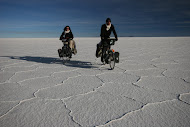At Torres del Paine National Park, we had the chance to camp near a big glacier, the glacier Gray. This huge tongue of ice flows into the lake Gray, where icebergs are pushed by the wind at the surface of the gray water of the lake. This glacier is a tip of the Patagonian icecap, the Campo de Hielo Sur (The Southern Ice Field). On the edge of the glacier, we can observe rocky areas free of vegetation, indicating that the glacier was once much longer and thicker. That also indicates that the glaciers were broader and retreated. But how far did they extend in the past?



We had a piece of answer where we least expected it. It was more than 150 km east of Paine, in the Argentine Pampa along the road 40. We were between Cerro Castillo and El Calafate. We were in a large plain, covered with dry yellow grass. But here, there were huge rounded blocks, as disposed in the middle of the plain. Intrigued, we paused to examine them more closely. These are blocks of igneous rocks (lava and granite), while there are only sedimentary rocks in the vicinity. The only place where we can find such kind of rock is in the main Cordillera, 150-200 km to the west. These blocks have thus been transported over long distances.
These blocks bear traces of scratches, as if they had been dragged against another rock. The rivers can not carry blocks of such a size on such a distance. The only explanation is the glaciers, which can carry rocks as big as houses over their entire length. When these rocks are transported at the base of the glacier, they rub against the rock and are like scratched. When they are close to the lower tip of the glacier, the blocks are released as the ice melts, as deposited there: they are erratic boulders. The presence of boulders in the Pampas shows that glaciers once covered the Pampas. The mapping of these boulders can provide a reconstitution of the total extent of glaciers in the past.
 An example closer to us (at least for French) illustrate the concept of erratic boulder. In Lyon, on top of the Croix Rousse district, is the "big stone", which is an erratic boulder left on the heights of Lyon by alpine glaciers during the last glaciation. This proves that not only the glaciers of the Alps flowed at least up to Lyon, but they were thick enough to drop blocks on top of Croix Rousse. We will see later other typical glacial features: the moraines.
An example closer to us (at least for French) illustrate the concept of erratic boulder. In Lyon, on top of the Croix Rousse district, is the "big stone", which is an erratic boulder left on the heights of Lyon by alpine glaciers during the last glaciation. This proves that not only the glaciers of the Alps flowed at least up to Lyon, but they were thick enough to drop blocks on top of Croix Rousse. We will see later other typical glacial features: the moraines. 
